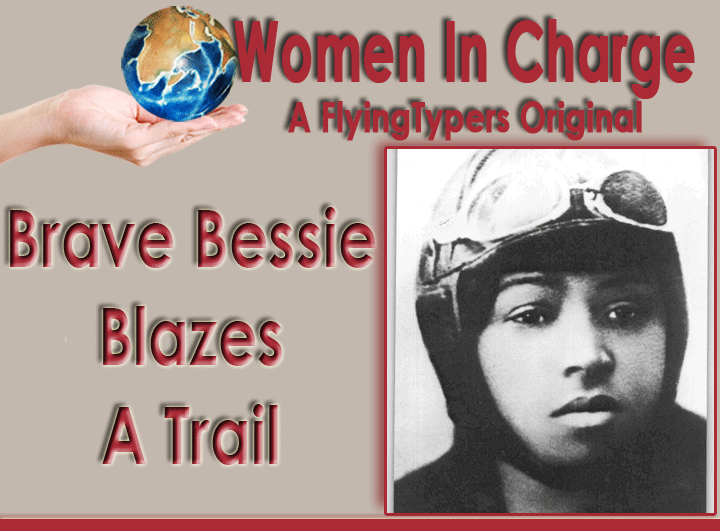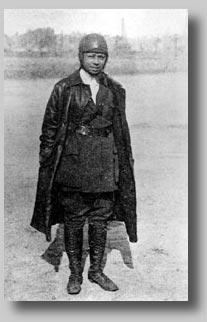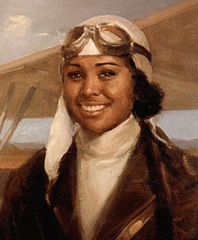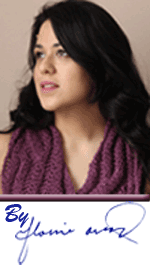
FlyingTypers
continues its groundbreaking series covering the courageous and pioneering
women of air cargo and aviation with a look back at pioneering aviatrix
Bessie Coleman.
 In
America, next Monday is Martin Luther King Day, February celebrates Black
History Month, and March celebrates Women’s History Month, which
beggars the question of where to place someone as historically significant
as Bessie Coleman. In
America, next Monday is Martin Luther King Day, February celebrates Black
History Month, and March celebrates Women’s History Month, which
beggars the question of where to place someone as historically significant
as Bessie Coleman.
One of 13 children, Bessie Coleman was
born in 1892 in Atlanta, Texas, to George and Susan Coleman, both African
American sharecroppers. The family was poor and could afford very little,
and once the children were of age they were expected to contribute to
the household income.
But Bessie had high-flying hopes. She attended
Langston University’s predecessor, the Oklahoma Colored Agricultural
and Normal University, but couldn’t finish due to a lack of funds.
At 23 years old, she moved to Chicago to live with her brothers and work
as a manicurist. Her fascination with aviation was sparked in Chicago,
where her brothers enticed her with stories of French women flying planes
in World War I.
Of course, when Bessie tried to enroll
herself in flight programs stateside, she was turned down. A woman aviator
was difficult enough to stomach, but a black woman aviator? One can only
imagine the mockery and derision she faced in 1920.
As a manicurist, Bessie had contacts with
many of the black elite of Chicago. She quickly befriended Robert S. Abbot,
publisher and owner of the Chicago Defender and one of the first
African American millionaires, who encouraged her to go to France to learn
to fly. He, along with others, helped fund her exodus, and she quickly
learned French in preparation.
On November 20, 1920, Bessie Coleman left
for France from New York City. She enrolled at Ecole d’Aviation
des Freres in Le Crotoy, France, the only African American in
her class. She learned how to fly in a rickety Nieuport Type 82 biplane
and within seven months received her pilot’s license from the Federation
Aeronautique Internationale. She briefly returned to New York City in
September 1921 and was celebrated in the black press—the Air
Service News called her “a full-fledged aviatrix, the first
of her race.”
Bessie realized she wanted to make her
living as a pilot, but in order to do so needed additional training as
a “barnstormer,” or stunt pilot—commercial aviation
was still a decade away from becoming a reality. She returned to Europe,
studying acrobatic aviation in France and then the Netherlands, where
she studied under pioneering aircraft manufacturer Anthony H.G. Fokker,
otherwise known as “The Flying Dutchman.” She moved on to
Germany, where she received additional training from one of the chief
pilots of the Fokker Corporation.
Her first air show took place on September
3, 1922, at the famous Curtiss Airfield in Garden City, Long Island. The
event was sponsored by her old friend Robert S. Abbot and honored the
all-black 369th American Expeditionary Force of World War I. She
was billed as “the world’s greatest woman flyer.”
Over the next five years “Queen Bess,”
as she was called, performed aerial stunts across the United States. She
always encouraged the African Americans attending her shows to learn how
to fly, and refused to perform in venues that denied admission to African
Americans. When she was offered a role in the feature-length film Shadow
and Sunshine, she accepted in the hopes it would help her fund her
dream of an African American aviation school. However, when she learned
her very first scene in the film would depict her in bedraggled clothes,
she refused the role. Doris Rich, author of Queen Bess: Daredevil
Aviator, wrote “she was never an opportunist about race. She
had no intention of perpetuating the derogatory image most whites had
of most blacks.”
“
|
Eventually, Queen Bess
made enough money to purchase her own plane: a rather old Curtiss JN-4.
It was only a few days after she received the plane that it stalled at
300 feet and nose-dived, crashing into the ground. With broken ribs, a
broken leg, and several lacerations, Bessie was relegated to a hospital
bed for 3 months.
Bessie returned to her home state of Texas
in June of 1925. She performed on June 19th, the anniversary of the day
African Americans in Texas were granted their freedom. After her show
the spectators were boarded onto five passenger planes for a complimentary
night flight over Houston—the Houston Reporter remarked
that it was “the first time [the] colored public of the South ha[d]
been given the opportunity to fly.”
While flying was one of Bessie Coleman’s
dreams, her greatest wish was to open an aviation school for African Americans.
She told the Houston-Post Dispatch that she wanted to “make
Uncle Tom’s Cabin into a hangar by establishing a flying school.”
She later opened a beauty shop in Florida to try and raise funds, and
gathered enough money to purchase an old Army surplus plane from World
War I to continue her stunt flying.
 On April 30, 1926, Bessie and her mechanic
William D. Wills boarded her new plane to rehearse for a May Day air show
the following day. The pièce de résistance of her act was
to be a daring parachute jump from 2,500 feet. Wills was piloting the
plane when it fell into a tailspin and flipped upside down. Bessie was
not wearing her seat belt and tragically fell out of the plane to her
death. Wills tried but could not regain control of the plane and also
lost his life. On April 30, 1926, Bessie and her mechanic
William D. Wills boarded her new plane to rehearse for a May Day air show
the following day. The pièce de résistance of her act was
to be a daring parachute jump from 2,500 feet. Wills was piloting the
plane when it fell into a tailspin and flipped upside down. Bessie was
not wearing her seat belt and tragically fell out of the plane to her
death. Wills tried but could not regain control of the plane and also
lost his life.
It took almost half a century, but in 1977
the Bessie Coleman Aviators Club was formed by a group of African American
pilots from Chicago. Every April 30th they fly over Lincoln Cemetery in
Chicago to airdrop flowers on her grave.
Today, African Americans can take great
pride in women like Mae Carol Jemison, the first black woman astronaut,
and Atlantic Southeast Airlines, which in 2012 flew with an all-woman
African American crew. But we must not forget about the pioneering Queen
Bess, whose lofty dreams and unwavering determination paved the way for
everyone else who followed. As Lieutenant William J. Powell said, “Because
of Bessie Coleman, we have overcome that which was worse than racial barriers.
We have overcome the barriers within ourselves and dared to dream.”
Flossie Arend |




 Vol.
18 No. 3
Vol.
18 No. 3